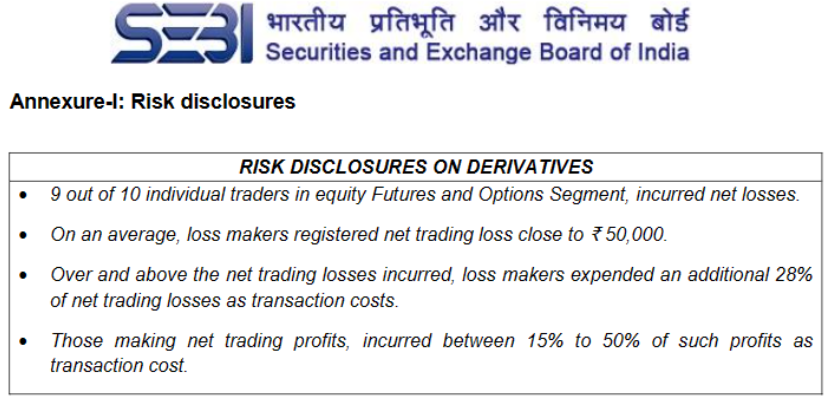NSE and BSE are the world's top two exchanges in terms of futures and options (F&O) volume. The turnover has reached such levels that the combined turnover of the two Indian stock exchanges accounted for 80% of the global turnover in the month of April.
First, what is F&O (Futures and Options)?
Futures and Options are types of agreements that allow you to speculate on the price movement of an underlying asset (like stocks, commodities etc.) without actually owning it. Futures is an obligation for the buyer to purchase the underlying asset at a predetermined price and date. Imagine you're a farmer growing corn. You expect to harvest your corn in three months. To protect yourself from the risk of corn prices falling before you can sell your harvest, you enter into a futures contract. In the contract, you agree to sell 1000 kgs of corn at $4/kg in three months. Regardless of what the market price is when you harvest your corn, If the market price drops below $4 per kg, you've protected yourself from that loss. If the market price rises above $4 per kg, you miss out on the extra profit, but you're still locked in a good price.
There's a tiny difference between futures and Options - in option contracts, the buyer has the right but not the obligation to buy or sell the underlying asset at the predetermined price and date. However, if the buyer chooses to exercise the option, the seller must honour the contract.

SEBI's risk disclosure for F&O traders
When you're trading, the value of these derivatives can be affected by various factors like market volatility, changes in interest rate, fluctuation in exchange rate etc. which are tough to predict. There are a lot of risks involved with futures and options trading. SEBI recognises this risk, which is why every time you log in to your trading account you see a 'Risk disclosures on derivatives' as mandated by SEBI.
F&O trading has become popular among retail investors primarily as a speculative tool to make a quick buck in the stock market. But really, retail investors are losing money. In Jan 2023, SEBI released data that showed 89% of the people in the F&O space were losing money but the volumes continued to rise despite that.

F&O trading is a risky game and this is why SEBI is stepping in
There has been a lot of chatter in the market about potential measures that SEBI may take to combat the rampant trading in the F&O space.
Currently, F&O trading in India is treated as business income. This means traders can offset losses against other sources of income and avail deductions and allowances (on expenses like brokerage, internet charges, and other related costs) applicable to business income. Both of these can help reduce their tax liability. Other than this, depending on the individual's income, the effective tax rate on F&O profits can be lower compared to other forms of income.
There has been discussion about treating F&O trading as speculative income rather than business income for taxation purposes. This could have significant implications. For starters, one can only offset profit out of F&O transactions against loss of F&O transactions, not against other income, and the deductions allowed under business income are not available. It will be taxed at the individual's applicable income tax slab rate along with other income sources, such as salary, interest, or rental income. So it also has the potential to increase the tax burden. Since losses won't be offset against other income, the tax rate will be higher, and deductions won't be available. Classifying it as speculative income might discourage retail investors from participating in F&O trading.

In June, SEBI put together a working group chaired by G Padmanabhan, former executive director of the Reserve Bank of India, to suggest measures to enhance investor protection and risk management in the derivates segment.
The discussions in the advisory committee revolve around:
- Increasing the F&O contract size to 25 lakh (from 5 lakh currently): Contract size refers to the quantity of stock, commodity or financial instrument that underlies an F&O contract. The proposed change might ensure that only serious players will come in.
- Only one expiry per week per exchange: Currently, the Indian market has multiple expiries for F&O contracts. The proposed change would consolidate all F&O expiries into a single expiry per week, per exchange. This means that instead of having multiple expiries throughout the week, there would be only one standard expiry day (e.g., every Thursday) for all F&O contracts on each exchange. This change aims to reduce volatility and increase liquidity.
- Higher margins closer to expiry: This is a direct way to manage risk. It means as the expiry date approaches the exchange may increase the margin requirements for traders holding positions in that contract. This means that traders must deposit more funds or collateral into their accounts to maintain their positions.
But it might be a while before any of these actually gets implemented. First, they'll probably introduce a consultation paper to seek public opinion and feedback, take comments, and only then issue a circular to make this happen. This could take a few months.
For now, all eyes will be on the budget and whether or not they'll classify F&O as a speculative income. Stay tuned to see what happens on July 23!

No comments:
Post a Comment